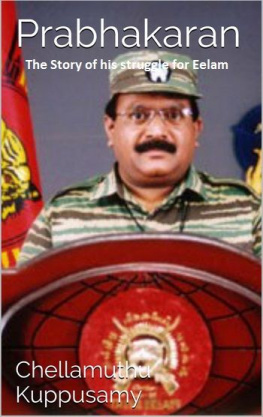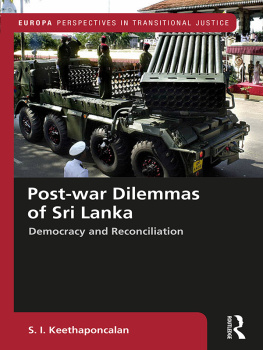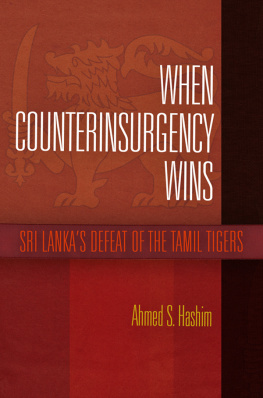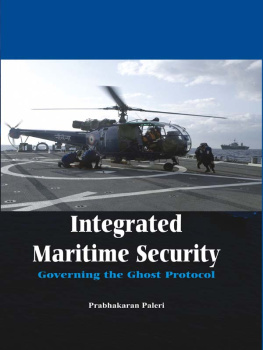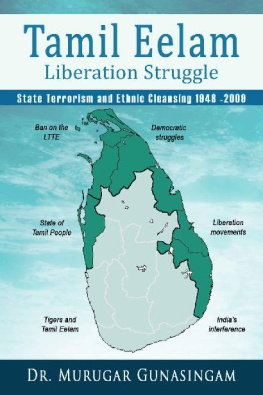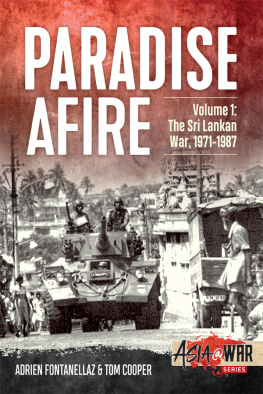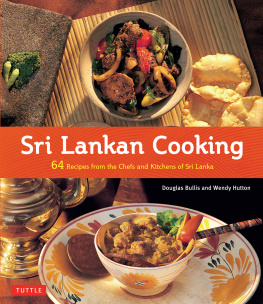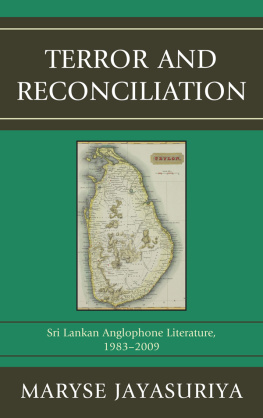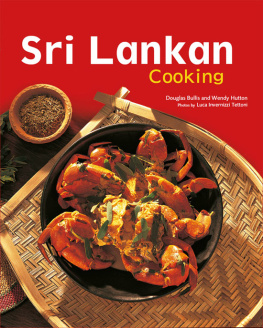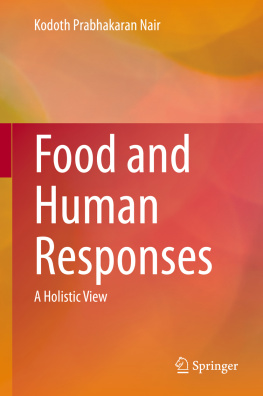Kuppusamy - Prabhakaran: The Story of his struggle for Eelam
Here you can read online Kuppusamy - Prabhakaran: The Story of his struggle for Eelam full text of the book (entire story) in english for free. Download pdf and epub, get meaning, cover and reviews about this ebook. year: 2013, genre: Politics. Description of the work, (preface) as well as reviews are available. Best literature library LitArk.com created for fans of good reading and offers a wide selection of genres:
Romance novel
Science fiction
Adventure
Detective
Science
History
Home and family
Prose
Art
Politics
Computer
Non-fiction
Religion
Business
Children
Humor
Choose a favorite category and find really read worthwhile books. Enjoy immersion in the world of imagination, feel the emotions of the characters or learn something new for yourself, make an fascinating discovery.
- Book:Prabhakaran: The Story of his struggle for Eelam
- Author:
- Genre:
- Year:2013
- Rating:4 / 5
- Favourites:Add to favourites
- Your mark:
- 80
- 1
- 2
- 3
- 4
- 5
Prabhakaran: The Story of his struggle for Eelam: summary, description and annotation
We offer to read an annotation, description, summary or preface (depends on what the author of the book "Prabhakaran: The Story of his struggle for Eelam" wrote himself). If you haven't found the necessary information about the book — write in the comments, we will try to find it.
Kuppusamy: author's other books
Who wrote Prabhakaran: The Story of his struggle for Eelam? Find out the surname, the name of the author of the book and a list of all author's works by series.
Prabhakaran: The Story of his struggle for Eelam — read online for free the complete book (whole text) full work
Below is the text of the book, divided by pages. System saving the place of the last page read, allows you to conveniently read the book "Prabhakaran: The Story of his struggle for Eelam" online for free, without having to search again every time where you left off. Put a bookmark, and you can go to the page where you finished reading at any time.
Font size:
Interval:
Bookmark:
Prabhakaran
The Story of His Struggle for Eelam
By Chellamuthu Kuppusamy
All rights relating to this work rest with the copyright holder. Except for reviews and quotations, use or reproduction of any part of this work is prohibited under the copyright act, without the prior written permission of the copyright owner.
Prabhakaran: The Story of His Struggle for Eelam
Chellamuthu Kuppusamy
Authors email: kuppusamy18@gmail.com
Table of Contents
A history of discrimination
Why didnt he hit back? asked Prabhakaran. It was indeed a simple question. He should have at least hit them back and shown some resistance. Is it not a natural surviving instinct? he thought.
Prabhakarans father, Thiruvenkadam Velupillai, was taken by surprise when his four-year-old son raised that question. Prabhakarans father had been an ardent follower of Thanthai Chelva. The title Thanthai (meaning father in Tamil) fitted S.J.V. Chelvanayagam very well, who had founded the Federal Party and was looked upon as a fatherly figure by the Tamils of Ceylon. He was also known as the Gandhi of Eelam , as he resembled Mahatma Gandhi and also preached the same non-violent methods which led to Indias freedom. Like Prabhakarans father Velupillai, the Tamils of Ceylon believed in Thanthai Chelva, and that nothing other than non-violence could give them equal rights in the island nation.
Chelvanayagam had advised his followers not to retort back even if death confronted them. The Hindu priest from Panadura did exactly that. He just followed the words of Chelva. Moreover, he neither had the courage nor the strength to strike back. It was an easy task for the mob as they poured kerosene over his body and burnt him alive. The priest was just one among the countless innocent Tamils who were killed mercilessly during the 1958 ethnic violence that spread across Ceylon. The Tamils of Ceylon were destined, rather cursed, to face the inevitable.
Velupillai was beginning to get little worried about his little boy.
*
Prabhakaran was born to Thiruvengadam Veluppillai and Parvathi of Valvettithurai on 26 th November, 1954, as the last of their four children. His siblings were Manoharan, Jegatheeswari and Vinothini. Prabhakaran, the youngest, was the familys favourite and everyone adoringly called him Durai (meaning lord or master). As a child, Durai invariably had a place on his fathers lap and also in his heart. Veluppillai and his fellow supporters of the Federal Party would usually meet at his home in the evenings and discuss about the racism and linguistic chauvinism exhibited by the Sinhalese politicians and the various attacks unleashed on Tamils. Little Prabhakaran would keenly listen to those conversations, but rarely reacted to them.
Veluppillais ancestors had constructed Hindu temples where they lived. Veluppillai himself was the treasurer of Vaitheeswaran Temple also known as Valavai Sivan Kovil - which was the largest in the coastal town of Valvettithurai. This temple was constructed by Prabhakarans ancestor called Thirumeniyar Venkatachalam. Prabhakarans ancestors had also assisted in the construction of two other temples - Nediyakadu Pillayar Kovil and Vallai Muthumari Amman Kovil . Prabhakarans mother Parvathi hailed from a family in Point Pedro, a town not far from Valvettithurai. Called Meththai Veedu Nagalingam family (Terraced house of Nagalingam), they were also known for bilding temples.
Annual festivals in Valavai Sivan Kovil were celebrated with grandeur, during which famous nagaswaram and bharathanatyam artistes from the southern Indian state Tamil Nadu performed. Prabhakaran would run around and do errands on such events. Swami Krupananda Variyar, a renowned Harikata exponent from India, gave musical discourses in 1950s and 1960s.
Prabhakarans father Velupillai was an ardent fan of Variyar and took Prabhakaran with him to listen to the discourses, not only in Valvettithurai but throughout the Jaffna peninsula. Prabhakaran respected the sagacious holy man as did his pious mother and sought his blessing during every visit. Variyar took pleasure in answering soul-searching questions from the excited youngster. Variyar had once reportedly told Prabhakarans mother that her son would one day emerge a Hindu revolutionary. Almost half a century later, Prabhakaran instead turned out to be an armed revolutionary.
*
Prabhakaran was naturally upset when he learnt about the priests burning. He had revealed this in his interview to N. Ram that appeared in The Hindu , in 1986: Ours is a god-fearing society and people are religious-minded. The widespread feeling was, when a priest like him was burnt alive, why did we not have the capability to hit back. That was one atrocity that made people think deeply.
Another incident agitated him further.In an interview to the Indian magazine Sunday , in 1984, he said: The shocking events of the 1958 racial riots had a profound impact on me when I was a schoolboy. I heard of horrifying incidents of how our people had been mercilessly and brutally put to death by Sinhala racists. Once I met a widowed mother, a friend of my family, who related to me her agonizing personal experience of this racial holocaust. During the riots, a Sinhala mob attacked her house in Colombo. The rioters set fire to the house and murdered her husband. She and her children escaped with severe burn injuries. I was deeply shocked when I saw the scars on her body. I also heard such stories of cruelty. I felt a deep sense of sympathy and love for my people. A great passion overwhelmed me to redeem my people from this racist system.
As Velupillais family listened to this shocking incident directly from the lady nearly a year later, they were horrified. Prabhakaran quivered in rage. But he was also clear on one thing. They should hit back. They wont do these things if they knew we could hit back, said Prabhakaran.
For the first time in the history of the island, the Tamils who were displaced were called refugees.
Prabhakaran was critical of the Sinhala leadership that added fuel to the fire instead of curbing the well-directed violence on Tamils. He was even more critical of the Tamil political leadership that was still preaching non-violence.
*
On the morning of 25 th September, 1959, Talduwe Somarama Thero had fixed up an appointment with the then Prime Minister Solomon Bandaranaike at his residence in Rosemead Place, Colombo. Solomon Bandaranaike was the instigator behind the 1958 ethnic violence. As Bandaranaike bent forward to pay obeisance to the Buddhist monk, Somarama Thero whipped out a revolver from the folds of his robe and shot the Prime Minister point blank in the stomach.
Solomon Bandaranaike had become the Prime Minister with the full support and blessings of the Buddhist monks. In return, the Buddhist clergy had asked him to declare Ceylon as a Buddhist Sinhala nation. It was an order, not a request. Bandaranaike was not quick enough to react, and the delay upset the Buddhist clergy. Bandaranaike had to be disposed off.
Wijeyananda Dahanayake succeeded Solomon Bandaranaike as the Prime Minister of Ceylon. His rule could not last long as he faced a no-confidence motion in the Parliament on the controversy surrounding Bandaranaikes assassination. The Parliament was dissolved on 5 December 1959. In the ensuing elections, Sri Lanka Freedom Party swept the polls, thanks to the sympathy wave created by Solomons demise.
Solomons widow Srimavo Bandaranaike became the Prime Minister in June 1960, creating history as the first ever woman head of state in the world. During her husbands tenure, an act called Sinhala Only Act had been passed in 1956. This law mandaded that Sinhalese would be the only official language for the government and judiciary. Though the law was enacted, it was not enforced. Srimavos first task, however, was to enforce the law strictly. She declared that from 1st January 1961, the Government and courts will start functioning only in Sinhalese.
Font size:
Interval:
Bookmark:
Similar books «Prabhakaran: The Story of his struggle for Eelam»
Look at similar books to Prabhakaran: The Story of his struggle for Eelam. We have selected literature similar in name and meaning in the hope of providing readers with more options to find new, interesting, not yet read works.
Discussion, reviews of the book Prabhakaran: The Story of his struggle for Eelam and just readers' own opinions. Leave your comments, write what you think about the work, its meaning or the main characters. Specify what exactly you liked and what you didn't like, and why you think so.

